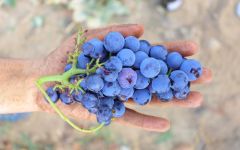Domaine de Cristia Chateauneuf-du-Pape Vieilles Vignes 2016
-
Jeb
Dunnuck -
Wine
Enthusiast -
Robert
Parker -
Wine
Spectator -
Wine &
Spirits



Product Details
Your Rating
Somm Note
Winemaker Notes
Professional Ratings
-
Jeb Dunnuck
One of the gems in the vintage is the 2016 Châteauneuf-du-Pape Vieilles Vignes, and it’s about as beautiful an example of old vine Grenache as I could imagine. Sporting a deep purple color as well as a huge perfume of blackberries, black raspberries, garrigue, crushed flowers, and exotic spices, it hits the palate with a wealth of fruit, a stacked mid-palate, awesome purity of fruit, and a finish that won’t quit. Made from 100% old vine Grenache from the sandy soils of the Cristia lieu-dit, aged in one-third new barrels, it has a certain accessibility even today but will be at its best in 2-4 years and keep for 15+. It’s the finest wine ever made by Baptiste and readers need to find bottles of this elixir!
-
Wine Enthusiast
This Grenache sourced from nearly century-old vines is a favorite amidst a stellar lineup of the producer’s 2016 Châteauneufdu-Pape. Grown on sand and clay soils, it’s a silken sip full of juicy black cherries shaded with granite, smoke and pepper. A fresh, mineral tang and taut, fine-grained tannins lend gravitas. While tightly woven still, it should ease and amplify from 2020 and stay at peak through 2040. David Bowler Wine. Cellar Selection
-
Robert Parker's Wine Advocate
The pure Grenache 2016 Chateauneuf du Pape Vieilles Vignes reached 16.5% alcohol yet carries it really well, showing just a trace of warmth. Cola, cedar and black cherry notes lead into a plush, full-bodied wine with supple tannins and remarkable length. Although it may age past a decade, there's no real reason to defer gratification.
-
Wine Spectator
Ripe, but bright and fresh, with a lively mix of raspberry, red currant and bitter plum coulis flavors streaming in, pulling light tea, singed sandalwood and anise notes along. Shows lovely detail and well-embedded acidity through the finish. Drink now through 2035.
-
Wine & Spirits
This 100 percent grenache makes the best of its vineyard’s cool northeastern exposure in its lift, grace and herbal detail. While it has the red-cherry concentration of fruit you might expect from vines averaging 90 years old, it also has a tanginess that brings to mind the snap of taut cherry skin, the acid rush of a fresh plum and the fragrance of a strawberry patch after a light rain. It feels complete and inviting, an elegant Châteauneuf for a duck salad.
Other Vintages
2020-
Jeb
Dunnuck -
Wine
Spectator -
James
Suckling -
Robert
Parker
-
Jeb
Dunnuck -
Wine
Spectator - Decanter
-
Robert
Parker
-
Jeb
Dunnuck - Decanter
-
Wine
Spectator
-
Jeb
Dunnuck -
Robert
Parker
-
Wine
Spectator -
Jeb
Dunnuck -
Robert
Parker -
James
Suckling
-
Robert
Parker -
Wine
Spectator
-
Robert
Parker -
Jeb
Dunnuck -
Wine
Spectator
-
Wine
Spectator -
Robert
Parker
-
Robert
Parker -
Wine
Spectator






Created by Etienne Grangeon 70 years ago, the property originally comprised 2 hectares of Grenache. It was developed further by the driving force of his son Alain, who joined the domaine in 1963. Passionate about viticulture, he notably contributed to the expansion of the domaine and planted improved grape varieties such as Syrah and Mourvèdre and created the identity of Cristia, based on the knowledge and respect of his soils.
Then, in 1999, Baptiste, Dominique and more recently Florent joined their father. Their priorities were to concentrate on selecting the best parcels in order to produce a wine of a great quality with a good ageing potential.

With bold fruit flavors and accents of sweet spice, Grenache, Syrah and Mourvèdre form the base of the classic Rhône Red Blend, while Carignan, Cinsault and Counoise often come in to play. Though they originated from France’s southern Rhône Valley, with some creative interpretation, Rhône blends have also become popular in other countries. Somm Secret—Putting their own local spin on the Rhône Red Blend, those from Priorat often include Merlot and Cabernet Sauvignon. In California, it is not uncommon to see Petite Sirah make an appearance.

Famous for its full-bodied, seductive and spicy reds with flavor and aroma characteristics reminiscent of black cherry, baked raspberry, garrigue, olive tapenade, lavender and baking spice, Châteauneuf-du-Pape is the leading sub-appellation of the southern Rhône River Valley. Large pebbles resembling river rocks, called "galets" in French, dominate most of the terrain. The stones hold heat and reflect it back up to the low-lying gobelet-trained vines. Though the galets are typical, they are not prominent in every vineyard. Chateau Rayas is the most obvious deviation with very sandy soil.
According to law, eighteen grape varieties are allowed in Châteauneuf-du-Pape and most wines are blends of some mix of these. For reds, Grenache is the star player with Mourvedre and Syrah coming typically second. Others used include Cinsault, Counoise and occasionally Muscardin, Vaccarèse, Picquepoul Noir and Terret Noir.
Only about 6-7% of wine from Châteauneuf-du-Pape is white wine. Blends and single-varietal bottlings are typically based on the soft and floral Grenache Blanc but Clairette, Bourboulenc and Roussanne are grown with some significance.
The wine of Chateauneuf-du-Pape takes its name from the relocation of the papal court to Avignon. The lore says that after moving in 1309, Pope Clément V (after whom Chateau Pape-Clément in Pessac-Léognan is named) ordered that vines were planted. But it was actually his successor, John XXII, who established the vineyards. The name however, Chateauneuf-du-Pape, translated as "the pope's new castle," didn’t really stick until the 19th century.
